

Going through the report data
In a web report, you can choose to show certain groups of records according to your requirements, and switch among the groups to see the data you want.
- Go-to
Enables you to obtain a different view of data by switching among groups.
- Go-to-by-value
Enables you to filter data based on a go-to action to obtain a more detailed view of the data.
- Go-down
Enables you to drill data to a lower-level group according to predefined hierarchies. For more information about hierarchies, refer to Defining hierarchies in the JReport Designer User's Guide.
- Go-up
Enables you to drill data to a higher-level group according to predefined hierarchies.
- Go-to-detail
Enables you to concentrate on the details of a group.
After a "going" action has been performed, the data presented in the component will be re-loaded from the data buffer, showing only the records in the selected group, and the new report created can be viewed, printed, and exported to other formats in the same way as the original report.
Assume you have created a chart report of Clustered Bar 2-D type on the business view WorldWideSalesBV in Data Source 1 of the SampleReports catalog in the Public Reports folder, which
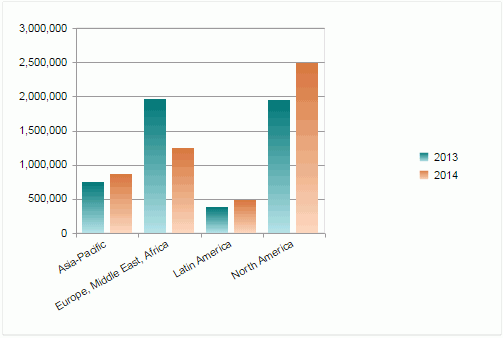
The business view WorldWideSalesBV has defined the following hierarchical relationship: Region > Country > State > City.
We will now take the chart as an instance to illustrate the going functions.
Go-to
The go-to action enables jumping to a different group by replacing the current. It is performed on chart categories and series.
- Right-click any value of Region, Asia-Pacific for example, and choose Go To from the shortcut menu. The list of groups available for "Go to" will appear on the submenu.
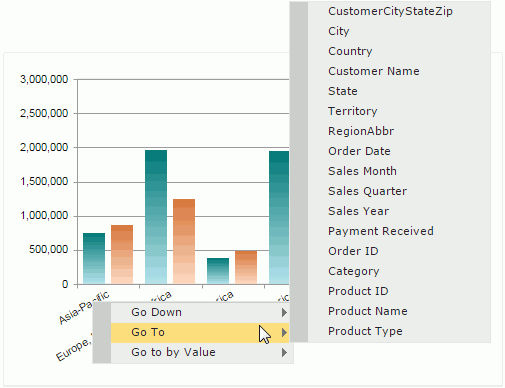
- Click State on the submenu, then in the regenerated result, we can see that State becomes the group for categories and Sales Year remains the group for series.
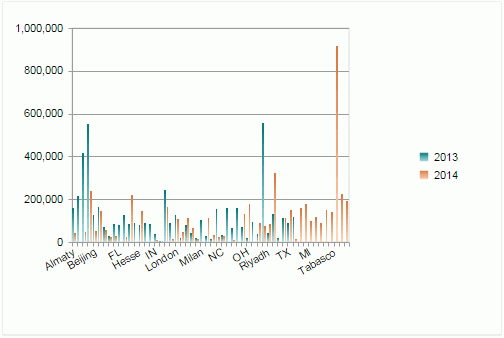
- To return to the original status, click the Undo button
 on the toolbar.
on the toolbar.
Go-to-by-value
The go-to-by-value action allows showing the information of another group while applying the current value being clicked on as a filter condition. It is performed on crosstab column/row headers, table groups, and chart categories and series.
- Go back to the original report in the above example.
- Right-click the value Asia-Pacific of the Region group, and point to Go to By Value on the shortcut menu. A submenu for the command is displayed, which lists the same items as those of Go To.
- Click State too and the result will be regenerated.
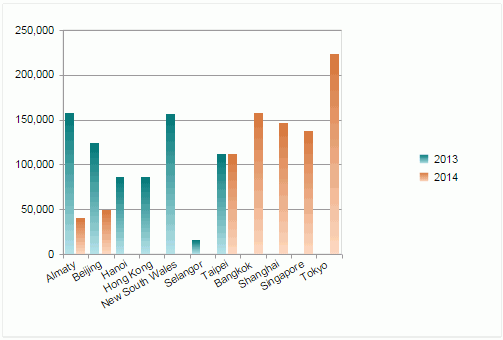
We can see that the result is different from that of go-to. This is because that, for the go-to-by-value action, the group of categories changes to State while being filtered by the Region value Asia-Pacific. That is, on the basis of the go-to action, a filtering action where Region = Asia-Pacific is performed at the same time, and thus the result of go-to-by-value is generated.
In addition, when a go-to-by-value action is performed, the "Go To" Filter panel will be displayed on the left of the Web Report Studio window, showing the group and the value that the filter is based on.
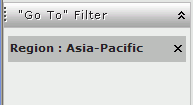
- To go back to the original report, click the Undo button
 on the toolbar.
on the toolbar.
Go-down
The go-down action allows going from a non-bottom level group to the one-level-lower group while applying the current selected value as a filter condition. It is performed on table groups, crosstab column/row headers, and chart categories and series.
- Go back to the original report in the above example, right-click the value Asia-Pacific, on the shortcut menu, point to Go Down, and we can see that Country is listed as the submenu item.
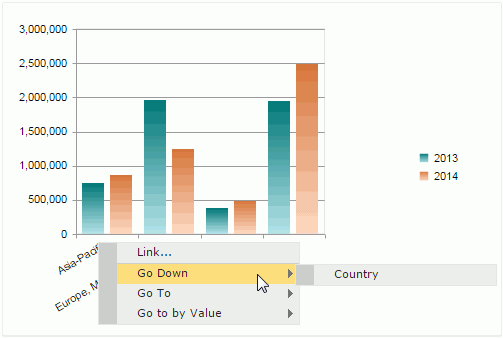
- Click Country to see the result. It displays the data about countries in the Asia Pacific region.
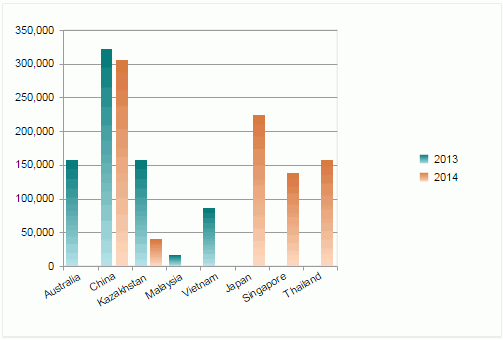
- The one-level-lower group for Country defined in the hierarchy is State. Now click China directly and JReport will go down to State.
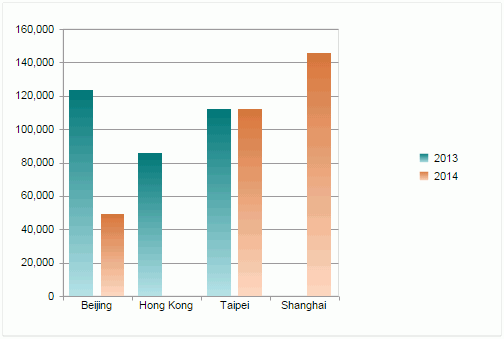
After these two go-down actions, we can see two filters are added in the "Go To" Filter panel, Region = Asia-Pacific and Country = China.
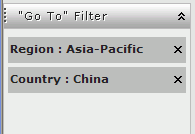
This is because, when you perform a go-down action, a filter will be created based on the value you click on. In this example, we first click on the Asia-Pacific region, so JReport drills this region one-level down to display countries in Asia Pacific, and thus the filter Region = Asia-Pacific is created. If you want all data in the one-level-lower group to be displayed when you drill down a group, you can remove the corresponding filter from the "Go To" Filter panel, by clicking X beside the filter condition.
Go-up
The go-up action allows jumping from a group which is non-top level in a predefined hierarchy to the one-level-higher group. It is performed on table groups, crosstab column/row headers, and chart categories and series.
- Based on the report result after go-down, right-click any value of State, Beijing for example, on the shortcut menu, point to Go Up, and we can see that Country is listed as the submenu item.
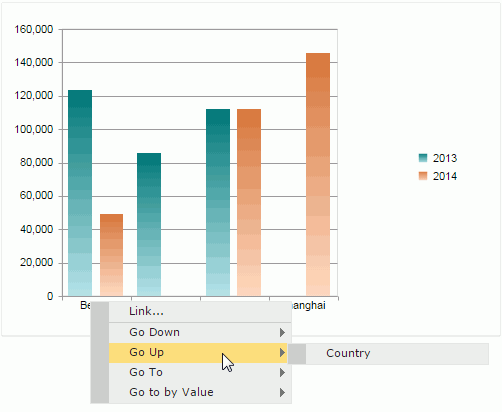
- Click Country to see the result. Country is now the group for categories and the filter condition Country = China is removed from the "Go To" Filter panel.

- The one-level-higher group for Country defined in the hierarchy is Region. Now right-click any value of Country, Singapore for example, on the shortcut menu, point to Go Up and click Region, the chart restores to the original state.

Go-to-detail
The go-to-detail action is performed on the summary of the tables, crosstabs and charts. First define a table and make it contain the information you would like to view about the summary values. Suppose that the summary is total sales in different countries. Then when you perform go-to-detail action on the value of total sales in France, you will get the table displaying the fields you defined and having applied the filter condition Country=France. When you go to detail of the total sales in another country, the table will display the data of that country.
To define the detail table for a summary and perform the go-to-detail action on it:
- Right-click any summary value (for a chart it is any data marker) and select Edit Detail Table from the shortcut menu. The Edit Detail Table dialog appears. See the dialog.
- From the Resources box, add the fields you want to display in the detail table of the summary. To adjust the order of the added fields, click
 or
or  .
.
- Click OK to finish defining the detail table.
- Right-click a summary value of which you would like to view the detailed information, then click Go to Detail on the shortcut menu. The detail table for the summary value will then be displayed, which shows the fields you have defined.
- To go back to the original report, click
 on the toolbar.
on the toolbar.
Notes:
- If the table type is Group Above, you can right-click its group header to show the shortcut menu so as to use the going function. For other table types, you have to right-click the group name in group column to perform going.
- The Going feature is not supported on org charts.
- You can also directly click group objects to perform the go-down action, however, if the group objects are also defined with some links,
- For web reports created in JReport Designer, you can go down to the next level with a single click only when the click priority of the go-down action is specified to be the highest at report design time. Otherwise, you have to use the Go Down command on the objects' shortcut menu to perform the action.
- For web reports created in Web Report Studio, you can only use the Go Down command on the objects' shortcut menu to perform the action. The link action takes the highest click priority by default and cannot be edited.







 on the toolbar.
on the toolbar.

 on the toolbar.
on the toolbar.






 or
or  .
. on the toolbar.
on the toolbar.